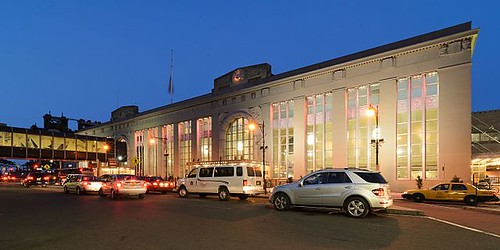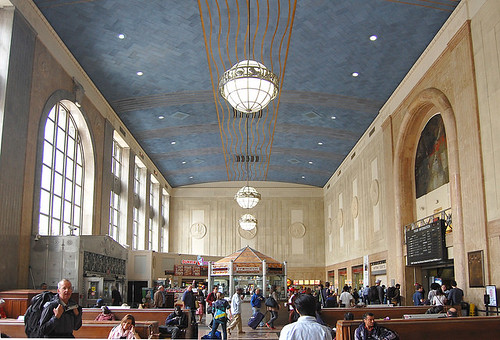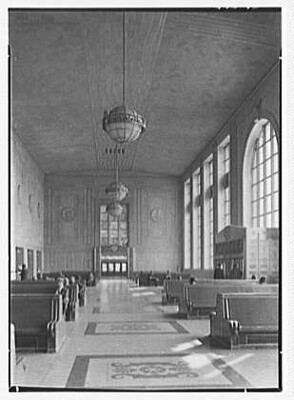Newark has its own Pennsylvania Station – and it’s getting a renewed lease on life. On the day that the Pennsylvania Railroad (PRR) opened its new, spacious, and grand Pennsylvania Station in Newark, on March 23, 1935, dignitaries, railroad executives and workers, and some 5,000 people gathered for a ceremony of much fanfare. Those on hand could enjoy a good look at new Pennsylvania Railroad and Pullman cars, and a state-of-the-art, streamlined GG1 electric locomotive. The dedication of the station, which combines classical proportions and majesty with the modernity of Art Deco design and flourishes, signified a state, region, and nation moving forward into the future out of the depths of the Great Depression. The PRR built new stations in Newark and Philadelphia in concert with new track, a lift bridge in Newark, and signal systems to electrify the rail line from New York to Washington, D.C.
Eighty-six years later, a major project in Newark Pennsylvania Station again is embodying investment in the future, in this case building on the past by a restoration and renovations of the 1935 station. Coming at a time when the Covid pandemic has stricken the nation and slow-but-sure signs of emergence are evident, the $190 million endeavor is far more than something physical. To be sure, it signals the resilience and strength that we see in a public building such as Newark Penn Station that has lasted and will continue to thrive through generations. It is the seventh busiest rail station in North America, according to the World Atlas. The station serves Amtrak’s Northeast Corridor, New Jersey Transit, and Port Authority Trans-Hudson Corp. (PATH), and is Newark’s main bus terminal. The investment in its Art Deco features also says that this is beauty and artistic expression worth valuing.
Work is already underway in a project that the State of New Jersey government projects will take five years, according to the plans that Gov. Phil Murphy first laid out in December. The first phase focuses on both aesthetics and functional upgrades, from restoring the classic benches in the station’s huge waiting room and updating bathrooms to deep cleaning of the limestone exterior. The complex of tunnels and platforms will get new directional and way-finding signage. Ultimately, the goal is to make Newark Penn Station more of a destination with additional dining and shopping options. For the station’s original construction, the City of Newark and PRR foot the costs. The State of New Jersey is committing the $190 million tab for this restoration and renovation.
The restoration will allow commuters and visitors alike to appreciate its remarkable architectural design and decoration. Those who are touting this restoration have noted the tragic fate that befell the region’s other, truly magnificent Pennsylvania Station in New York City, which the Pennsylvania Railroad demolished in 1963, and are thankful that this building has survived the vicissitudes of transit through the decades. Like that Penn Station, the renowned firm of McKim, Mead, and White designed Newark’s Penn Station. It was the company’s last major public building. As such, it reflects McKim, Mead, and White’s adherence to formal classical design, though not in a pure approach, as it embraced the bold, modern forms and thematic influences of Art Deco, which abound.
The building’s limestone exterior is massive, conveying its importance as a temple of transport, yet with welcoming stylistic elements. The classical symmetry is found in two huge archways; the classical order of base, column, and entablature; and evenly spaced pilasters. Between each of the pilasters are tripartite polished aluminum-trimmed windows that reach more than 30 feet, with spandrels that run across. The windows provide an abundance of natural light to the main waiting room, as does the expanse of glass within the huge archways.
Newark Penn Station
Photo: King of Hearts Gallery / Wikimedia / CA By-SA 3.0
With the subdued color of the gray limestone (and as it is deep cleaned), the profusion of Art Deco flourishes, material choices, and decorative forms can stand out more. The spandrels each hold a large aluminum bas relief of a flower in full bloom. The archways, of pink granite, hold motifs of flowers and fruits at their rounded corners, with bands of sculpted flowing ribbons. (In including Amtrak Newark Penn Station on its site devoted to “The Great American Stations,” Amtrak describes the ornamentation in elaborate detail.)
Those who designed the station ensured the Pennsylvania Railroad’s identify was forefront, and related images of on-the-clock train travel for its importance and efficiency: The railroad’s name is carved in stone, in large letters, above the archways and windows. Sculpted panels above the pilasters display the PRR’s keystone emblem, surrounded by boughs of leaves. Panels under the cornice depict freight that the PRR trains transported, such as wheat and livestock. Art Deco expression is carried out, with a clever bit of branding, in the form of stone pediments above the roofline that have stylized flower and vines, alternating with hourglasses, surrounding a large clock. The clock has the PRR’s keystone emblems for the clock marks at the 12, 3, 6, and 9 positions.
Waiting Room, Newark Penn Station
Photo: Daniel Wright / Flickr Set / CC BY-NC-ND 2.0
The station’s interior carries the same classical, balanced proportions with striking Art Deco features and exquisite materials, particularly in the light-filled main waiting room. Thankfully, this space is getting sustained attention in the project. More than 40 feet high, the room has a rich blue, gently sloping ceiling of patterned acoustic panels, set off with long, wavy gold lines. The project includes restoring the original curved benches, made of gray walnut with large inlaid aluminum PRR keystone emblems flanked by stylized tall flowers.
The main hall possesses other materials and highlights of a place built for the ages. Its red terrazzo floors have brass-trimmed black and yellow insets with floral motifs. The themes of the evolution of transportation – a common Art Deco theme of the period – are evident in four sculpted medallions, showing a canoe, covered wagon, electric locomotive, and airplane. Many a rushing commuter surely appreciates, though may not pause at, the two sumptuous Art Deco doorways of aluminum grill work and glass on the north and south. Each has a clock atop a pediment, with garlands flowing out, and rectangular side-door trims with cut-out panels of stylized flowers and fluted pedals. These doors are as fine Art Deco expression as exists anywhere.
Doorway, Newark Penn Station
Photo: Daniel Wright / Flickr Set / CC BY-NC-ND 2.0
One could go on and on about the attention going to the architectural and artistic treasures of Newark Penn Station, yet it’s crucial how this five-year project pairs the aesthetic with major functional, technological, and public-focused improvements. Travelers will benefit from updated restrooms, enhanced HVAC and air-handling systems, more ADA-compliant elevators, brighter lighting, and new way-finding and directional signage. Originally, as its listing on the National Register of Historic Places highlights, Newark Penn Station was unique in how it brought together so many transportation modes – intercity rail, local transit, commuter railroad, rapid transit, and bus lines – divided essentially into four tiers. A future goal is to augment the dining and shopping amenities on the concourse, Gov. Murphy said. The attention it is receiving now, through this significant investment, comes for a public place that has been, perhaps, undervalued. It promises to bring an illustrious, historic station strongly into the future.
Whether daily commuters, long-distance travelers, tourists, regional residents, transit nerds, or architecture lovers – and people who embody combinations of these – many are sure to benefit from the vision this project entails. With the announcement and project start coming amid the Covid pandemic, it says so much about the importance of investment in our historic public buildings. We have learned even more to not take such places for granted. As someone who has traveled countless times through Newark Penn Station, and maybe did not give it due regard, I look forward to treasuring this extraordinary place in the ways it deserves.
Newark Penn Station epitomizes the power of endurance.
Waiting Room, Newark Penn Station, June 1935
Photo: Gottscho-Schleisner Collection, Library of Congress, Prints and Photographs Division







No Comments so far ↓
There are no comments yet...Kick things off by filling out the form below.